 Talking in the 19th Hole
Talking in the 19th Hole
DRIVER..
. In the '70s and '80s, when I worked as a caddy at the Culiacan Country Club, I realized that
some players and caddies were dishonest in the game. Unfortunately, after more than 40 years, I consider
that behaviors that reflect dishonesty continue to be repeated.
In those years, I don't remember seeing or reading the rule book. I remember that golfers played by
accommodating the ball; this means that they moved it to have a better lie (position). That was a local
custom that some players took advantage of to move the ball from 10 or more yards from the green to
the fringe; if they were for a chip or pitch, they ended up using the putt. This custom violated the current
rules, but in those years, golfers played like this in Culiacan.
Years later, golfers began to play without moving the ball, but some players found it difficult to change
their old ways. In all clubs, some players are known to play “footgolf” because they move the ball with
their feet, and there are other players who are good boxers at the Floyd Mayweather or Manny Pacquiao
levels because they are good at taking off the strokes. But dishonesty in golf goes beyond moving the
ball or taking off the strokes.
The rules are clear: “all players are expected to play in the spirit of the game by acting with integrity, for
example, by following the Rules, applying all penalties, and being honest in all aspects of play.” (Rule
1.2a). The writers of the rules considered integrity so vital that they included it in rule 1. The caddies,
pros, players, and executives must be an example of this principle, teach it to new players, and be firm
in that it is followed.
Let's look at examples of the most common dishonest behaviors. The objective is that:
- Players and caddies know that behaviors are not appropriate in golf
- Players and caddies know what behaviors are correct.
- Let's all add so that dishonesty decreases or disappears from our clubs.
I will use some anecdotes for teaching purposes. The anecdotes could have happened in any club, so
don't take it personally.
- The discus thrower. Some caddies and players go ahead of their group to reach the green first to
mark the ball, but instead of placing the ball-marker behind the ball, they throw it forward to bring
it closer to the hole. Sometimes the ball-marker rolls and is so close to the hole that even the player
himself is ashamed of the trap he made.
- Taking advantage of marking the ball. When marking the ball, some caddies and players place the
ball-marker a few inches forward and then place the ball other inches forward. In this way, they take
advantage and leave a putt of less distance. The distance the player is ahead is directly proportional
to the distance that other players are watching.
- Make a path to the hole. Some players flatten the green with their putt, making a path from the ball
to the hole. The rules say that “a player may repair damage on the putting green without penalty by
taking reasonable actions to restore the putting green as nearly as possible to its original condition.”
Still, they prohibit “creating a path to the hole.”
- The egg layer. When the player's ball may be lost, the caddy or player goes ahead to look for it, but
they are prepared with an egg (another ball of the same brand and number) to put it in if necessary.
If they can't find the ball, they proceed with their plan. The egg must be placed discreetly.
Surprisingly the egg appears in a good position. To discover the egg layer, it is necessary to find the
ball in play to reveal it.
- The pitcher. Some caddies go ahead of the group, supposedly to see the players' balls, but in some
cases, they do it to move the ball, if necessary. Some caddies are not satisfied with kicking the ball;
instead, they throw it with their hand to advance it as close to the green, to the extent that some hole
in one, eagles and albatrosses are attributed to the skills of the caddy to throw the ball
- The bulldozers. There are players who are good “to improve the conditions affecting the stroke”
There are some very cheeky ones who crush the grass behind the ball with their feet or alter the
surface of the ground with the club by raising an edge where they place the ball (make a burrito).
Others are more discreet and crush the grass with the clubhead. If the ball is in a position where the
player would use a short or medium iron, the player may use it up to a wood after these actions.
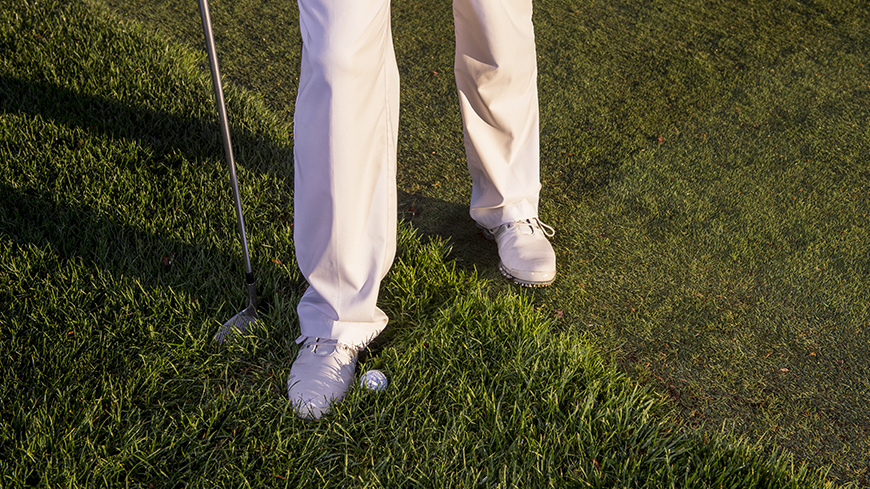
- The actors. Some players deliberately move the ball to improve their position. This is not the classic
“footgolfer” who kicks the ball a few yards. In this case, the player gives the ball a little push to
improve his position. He does it before the address or on the address. He can do it with his feet or
the club. Another outstanding performance by some players is when they do a whiff. They pretend
they didn't try to hit the ball, their performance almost convinces us, but the difference between a
practice swing and a whiff is noticeable.
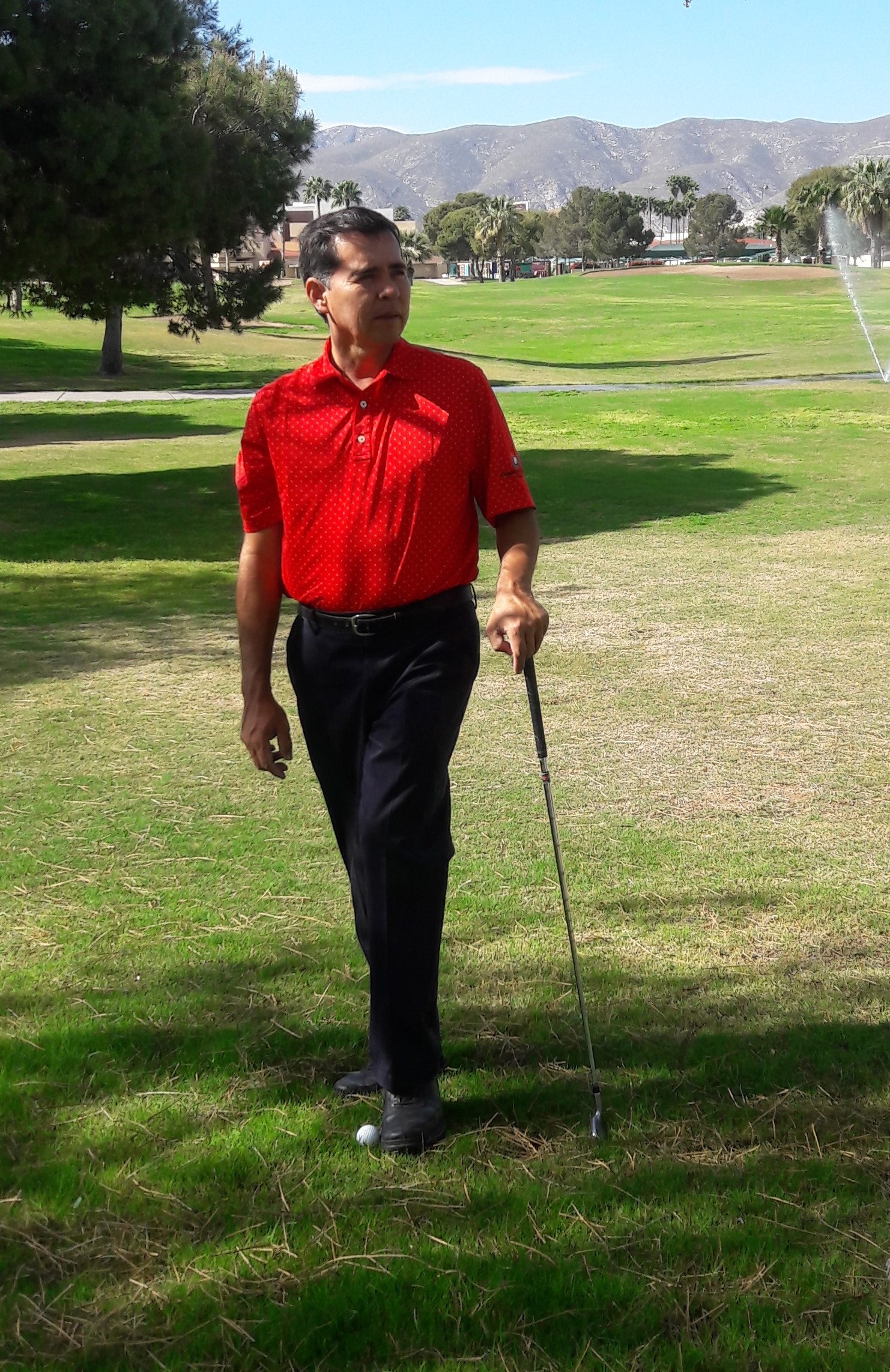
- The counter. Some players to hole the ball say the strokes they made, but say a number less than
correct to see if the other players accept it. If no one claims, his lie works, but if someone claims, the
player continues to count to the correct number of strokes. For example:
Player A: “four.”
Player B: “hey, it wasn't four.”
Player A: “five, six; is that I was counting.”
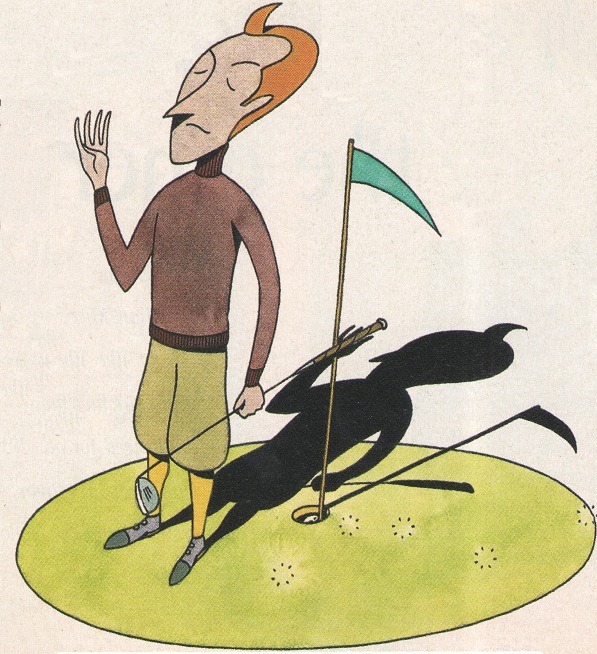
- The distractor. Some players enjoy distracting other players when they go to make their shot. Some
of the traditional ways to distract are:
- Paste and detach the velcro from the glove.
- Pretend to sneeze.
- Move or walk.
- Stand on the line of play or close to the player
- Put the shadow of the body, club, umbrella, etc., on the ball or line of play.
- Start the cart.
- Call by cell phone.
- The dart launcher. Some golfers are good at handling subtle language. His words are poison darts
that psychologically attack the other players. Some examples are:
- “You are playing very well; you are beating me.”
- “If you continue like this, you will break your record.”
- “Good ball” (when it is evident that it was a bad shot).
- “Beware of the lake.”
- “Do not be short.”
- “Please, can you move because you distract me.”
- The counselor. Some golfers say phrases or give unsolicited advice with the obvious intention of
misleading and confusing other players. For example:
- “I think you are taking your eyes off the ball.”
- “You are swinging very fast.”
- “I should have used iron 5.”
- “The green is very fast.”
- “I hit the ball very well, and it didn't reach the green.”
- “If I were you, I would hit over the top of the trees.”
- Aim the player. Caddies continue the custom of aiming the player in violation of the rule that says
that “when a player begins taking a stance for the stroke and until the stroke is made: the player’s
caddie must not deliberately stand in a location on or close to an extension of the line of play behind
the ball for any reason”.
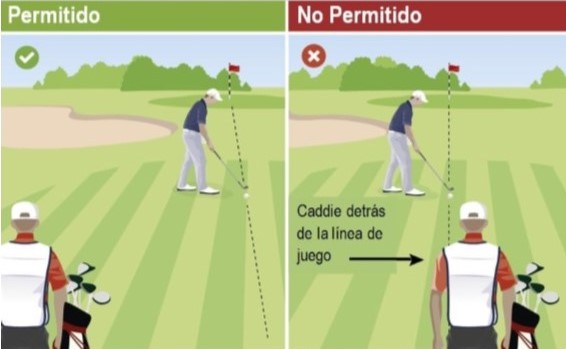
- The gardeners. Some caddies and players look like gardeners when their ball is in the rough, in tall
grass, or near the branches of bushes and trees. Some of the actions that they perform that are not
considered appropriate are:
- “Deliberately moving, bending or breaking branches with a hand, a leg or the body to get them
out of the way of the backswing or stroke.
- Standing on tall grass or weeds in a way that pushes them down and to the side so that they are
out of the way of the area of intended stance or swing, when a stance could have been taken
without doing so.
- Hooking one branch on another or braiding two weeds to keep them away from the stance or
swing.
- Using a hand to bend a branch that obscures the view of the ball after taking the stance.
- Bending an interfering branch in taking a stance when a stance could have been taken without doing so.”
- The elastic man. Some players claim to “use a clearly unreasonable stroke to get relief from
an abnormal course condition.” For example, a player's ball is in a bad lie near an immovable
obstruction (cart path, sprinkler, etc.). The player, to get relief, takes his stance, stretching his leg
like the elastic man to step on the immovable obstruction and get relief. Since the player's stance is
clearly unreasonable, relief is not allowed, and he must play the ball as it lies.
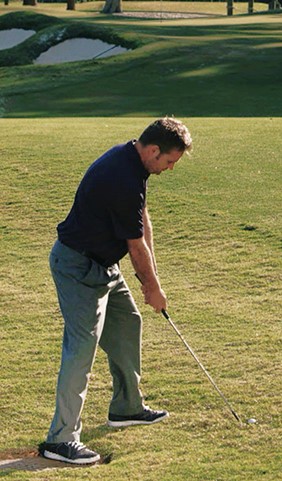
- • The legends. There are players whose cheating becomes true legends of the art of cheating. For
example:
- The player carried a sprinkler cover in his golf bag. When the player was in trouble, he placed
the cover in the area of the intended stance and took relief as an immovable obstruction.
- The player who pretends to remove loose impediments but actually, he teed up his ball.
- The player who pretends to hit from the bunker, but he or his caddy throws the ball onto the
green with his hand.
- The player who loses the bets and pretends to feel bad to withdraw.
- The player offers money to the person who measures the closest to the pin to record a distance
that allows him to win a prize.
- The hustler. Hustlers are the players who deliberately control the scorecards they give to the
committee to increase their handicap. The player manipulates his scorecard:
- Intentionally doing more strokes on some holes.
- Registering more strokes than those made.
- Delivering fake scorecards, even without having played.
The caddies are sometimes the ones who alter the scorecards to increase the handicap of their player.
- The caddies are sometimes the ones who alter the scorecards to increase the handicap of their player.
- The conspirators. Collusion is that “two or more players deliberately agree to ignore any Rule or
penalty they know applies.” Some of the most common agreements are:
- Agreement for gimme putts. There are players who “in stroke play, two players agree to
consider putts within a club-length of the hole holed, when they know that they must hole out
on each hole.” Some players concede the gimme putts when the ball is on the green.
- Agreement for a ball that is out of bounds to be dropped at the spot where it left the course, with
a penalty stroke.
- Agreement to move the ball
- Agreement not to apply the 14-club rule.
- Agreement not to respect the rules.
The penalty for agreeing to ignore the rules is a disqualification. The maximum penalty is imposed
because violators betray the trust that others deserve and break the game's spirit by not showing
integrity.
- Serious breach. “Many Rules require a player to determine a spot, point, line, area or other location
under the Rules, such as:
- Estimating where a ball last crossed the edge of a penalty area,
- Estimating or measuring when dropping or placing a ball in taking relief, or
- Replacing a ball on its original spot (whether the spot is known or estimated).
Such determinations about location need to be made promptly and with care but often cannot be
precise. So long as the player does what can be reasonably expected under the circumstances to make
an accurate determination, the player’s reasonable judgment will be accepted.”
The problem is that players in their quest to win lose their reasonable judgment. For example, they
decide their ball last crossed the margin of a penalty area 20 or 30 yards ahead of where it is known
or virtually certain that it crossed, gaining a significant advantage.
- The negotiators. Negotiating a good score is a situation that occurs in tournaments and tours where
there are groups of 2 or 3 players, usually those with the highest handicap in the category. I knew a
tour where lower-level youth players, the first day they were shooting low scores, but the second day
they were shooting high scores. It was evident that the first day they deliver scorecards with false
results. The tour decided to put scorekeepers in the 14-15 and 16-18 categories because they couldn't
trust them to be honest.
Sadly, some players agree to deliver fake scorecards. Negotiating the result that each player will
have, makes the whole group deliver low scorecards. It is obvious that they cheated.
- Filling out a scorecard at the end of the round. In tournaments, some players have the bad habit of
carrying a general scorecard and filling out the official scorecard at the end of the round. The rules
state that “after each hole during the round, the marker should confirm with the player the number
of strokes on that hole (including strokes made and penalty strokes) and enter that gross score on the
scorecard.” Filling out the official scorecard at the end of the round encourages players to record
fewer strokes, negotiate a lower score, etc. This custom has caused the disqualification and sanction
of players.
- The tango dancers. The Argentine saying says that “it takes two to dance the tango.” In golf, the
caddy and player are a team, but “a player is responsible for his or her caddie's actions during a
round”. Some players ask the caddy to move the ball, support him when they say a false score, alter
the scorecard, etc. Some caddies record a lower score to earn the tip, move the ball because they
want their player to win, change the bets' accounts, etc. It takes two to cheat. If the player were
honest, he would not accept a cheating caddy. If the caddy were honest, he wouldn't work a cheating
player. The club must sanction dishonest caddies before they cause a severe problem. Dishonest
players will gradually be left alone because nobody wants to play with cheaters.
There are other ways that players and caddies are dishonest. The problem has many edges. Some of the
most complicated are:
- Players do not accept their mistakes, even when there is evidence of them.
- Executives do not dare to punish dishonest behavior so as not to have problems with their
friends.
- Players' eagerness to win money or a trophy brings out the darkest part of their personality.
- Players seem to get amnesia when a rule doesn't suit them.
- Caddies sometimes contribute to dishonest behavior by looking good to the player and
sometimes ignoring the rules.
We may not be able to change caddies and players who are old sea wolves into cheating. Still, we can
start by changing ourselves and teaching boys, girls, youth, and the new generations of ladies and
gentlemen to act with integrity as established by the rules.
FORE.
 Talking in the 19th Hole
Talking in the 19th Hole




